It’s springtime, and we all know what that means! Bright and cheerful flora; adorable, baby animals; a newfound will to embrace the mentality that life is a breath of fresh air/a box of chocolates/any other idiom that instills hope and wonder… But also… stinging caterpillars. The gift that keeps on giving… rashes, burning sensations, nausea, and so much more.
Let’s be honest, though; these hungry, little larvae have a bit of an unfairly earned bad reputation. While their stinging spines and hairs can pack a quite a spicy punch, their position on the team is undoubtedly defense rather than offense; these caterpillars are by no means going to go out of their way to sting you (although that would be pretty scary if there was an aggressive, stinging species of caterpillar)! With all of this in mind, the best way to avoid a trip to your doctor (or at least the hot tears of embarrassment by being bested by a bug) is to always observe wildlife, but no touchy! But if it makes you feel a little bit better, here are some of the major caterpillar culprits to avoid in the Houston area:
Southern Flannel Moth/Megalopyge opercularis
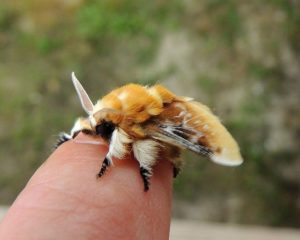
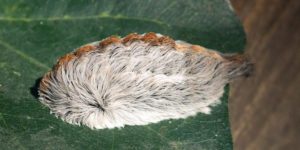
Look at this thing. No, like, honestly, LOOK at this thing. Personally, I think it’s rather insulting that something so cute and innocuous has the AUDACITY to have venomous spines that can impart the visceral sensation that has been described to be like BLUNT FORCE TRAUMA. I like to think that it has something to do with the downright rude nicknames we mere humans have given them: puss moth, wooly slug, asp caterpillar, opossum bug (I actually had never heard of that one before, but it was on Wikipedia, so it must be true, right?).
Once you’re stung, you can expect nausea, burning/throbbing pain at the location of the sting, swelling, a gross rash that will eventually look like a weird hickey, and even difficulty breathing. I personally have never experienced the sting of an asp, but I had a friend who did… and she did cry a lot… but she did survive!
No Touchy Factor: 8.9 out of 10. You will be so, so sad to be stung. You will never forget this sting.
Tussock Moths
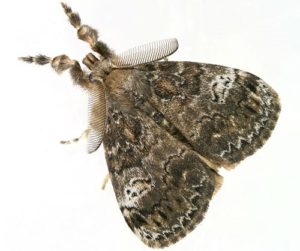
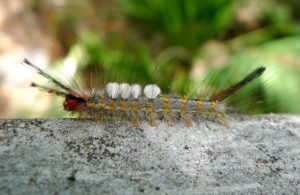
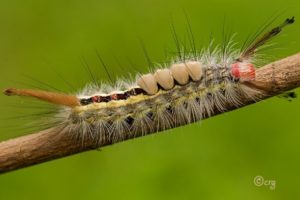
Listen… I feel a little bit bad saying this, but when I look at an adult Tussock Moth… I’m honestly just sad for it (and there are plenty of Tussock Moth species to be bored by, don’t you worry!). So drab. So boring. Nobody wants to sit with it at moth lunch in the cafeteria a Moth High School. Females usually have sad, useless wings and spend most of their short, adult lives waiting around for males to breed with them like a Victorian damsel with some flavor of wasting disease.
Where they lack in adult beauty and intrigue, though, they make up for it as caterpillars with… an interesting aesthetic. Like I said, there are lots of Tussock Moth species… so if you see a caterpillar that you’re uncertain about, ask yourself, “Does it remind me of a postmodern art piece made up of toothbrush bristles and pipe cleaners?” Chances are, it’s probably a Tussock Moth baby, then.
But what does the pain feel like if you rub up on one?! The good news is, they aren’t venomous (yay!). The bad news is, you’ll probably get an itchy rash that will probably be embarrassing to look at. Not pleasant, but you are strong and you will persevere.
No Touchy Factor: 6.3 out of 10. More annoying than ouchie, but might push you over the edge if you’re on the verge of having a bad day.
Saddleback Caterpillar Moth/Acharia stimulea
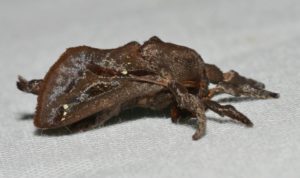
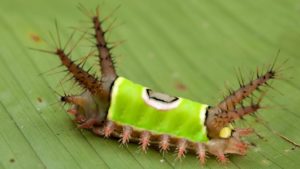
This species honestly gives me the heebie jeebies. Their larval stage is giving me “kind of creepy, kind of cute” energy initially, but if you look at one for too long… I’m not convinced that they wouldn’t psychically link with me and pull an “Invasion of the Body Snatchers” scenario. And their adult stage isn’t that much better; they kind of remind me of a shrouded and weathered prophet who has been wandering in the desert for 12 years and now knows the dark, impending secrets of things to come. Regardless of my feelings about them, though, a Saddleback Caterpillar is pretty unmistakable with its iconic green poncho and prickly, fleshy horns. Impress your friends! Correctly ID a caterpillar!
The sting… not so fun. Those pointy, little hairs (urticating hairs if you want to get really fancy!) excrete and nasty venom that can cause (drum roll, please!)… crazy headache, explosive diarrhea, rupturing electrolytes (what does that even mean?!), trouble breathing, anaphylactic shock, and hemorrhaging. Fun! The super scary part of these guys, in my opinion, is that even their little, mothy cocoons have those nasty urticating hairs! So… beware falling Saddleback cocoons? None of us are safe. No Touchy Factor: 8.2 out of 10. Plan on wallowing in your pain and misery.
Io Moth/Automeris io
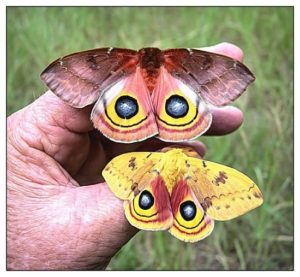
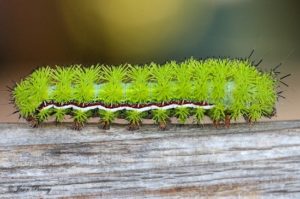
She’s giving Billie Eilish after touching something really static-y, she’s giving pinstriped couture, she’s giving neon firecracker extravaganza. She’s also giving major owwies. While Io Moths aren’t going to a main character in the Houston moth scene, they’re definitely a supporting character that you tactile interactions with. Armed with two different types of spines (point-bearing spines and seta-bearing spines), Io caterpillars are definitely giving off the immediate vibe of, “Please don’t.”
While Io Moth caterpillars definitely looks like they’re going to bring the drama in regard to their sting, I would put them in the “meh” category of pain. Sure, it’s gonna burn if you touch them. Sure, it’s gonna swell up like a balloon… but only for a few hours. You’ll be fine.
No Touchy Scale: 5.2 out of 10. I don’t really feel sorry for you. Sorry, not sorry.
Buck Moth/Hemileuca maia


Here it is… the moth for which this blog is named after… the notorious Buck Moth caterpillar. Small, drab, spiky… but with a reputation that strikes fear into the hearts of brave men across the vast ecosystem of south Texas. That being said… I think these little guys are all hype. Like, don’t go out of your way to get stung, obviously. I have to say though, I don’t super understand how these little guys earned their toxic reputation.
The sting… it’s going to burn, you’ll get a blistery rash… but that’s about it. Take a Benadryl and some Advil, and you’ll be back on your feet avoiding caterpillar stings in no time.
No Touchy Scale: 4.3 out of 10. Honestly, it’s no big deal.
While all of this information has obviously been presented in a cheeky manner, there are some things to definitely keep in mind if you have been stung by ANY caterpillar:
- If the caterpillar had any urticating hairs, use a piece of tape to remove any of the spines that broke off in your skin.
- Wash the stung area with soap and water.
- Hydrocortisone or antihistamine creams will be your best friend when it comes to itchiness.
- If you develop blisters, it’s always a good idea to contact your health care provider just in case.
- If you are experiencing signs of anaphylactic shock, go see your health care provider. ASAP.
All this being said regarding any wildlife, it’s always the best practice to look, but don’t touch… even if it’s a caterpillar that you know it will for sure not sting you. I don’t know about you, but I personally don’t love being poked by random people… but I DO love being gawked at. I think most wildlife feels the same way(?).
Taking all of this into consideration, enjoy the spring with or without the slow burn of a caterpillar sting. Good luck!
Visit the Cockrell Butterfly Center and learn more about moths, butterflies and other fascinating insects in person today!






